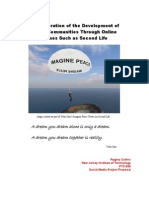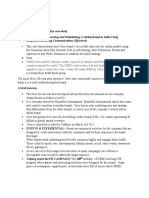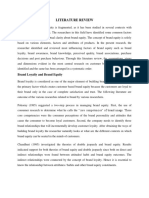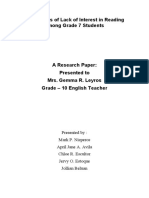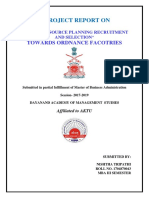41.evaluation of Brand Equity Based Aaker Model (Case Study LG & SAMSUNG)
41.evaluation of Brand Equity Based Aaker Model (Case Study LG & SAMSUNG)
Uploaded by
Larisa TagartaCopyright:
Available Formats
41.evaluation of Brand Equity Based Aaker Model (Case Study LG & SAMSUNG)
41.evaluation of Brand Equity Based Aaker Model (Case Study LG & SAMSUNG)
Uploaded by
Larisa TagartaOriginal Title
Copyright
Available Formats
Share this document
Did you find this document useful?
Is this content inappropriate?
Copyright:
Available Formats
41.evaluation of Brand Equity Based Aaker Model (Case Study LG & SAMSUNG)
41.evaluation of Brand Equity Based Aaker Model (Case Study LG & SAMSUNG)
Uploaded by
Larisa TagartaCopyright:
Available Formats
ijcrb.webs.
com
INTERDISCIPLINARY JOURNAL OF CONTEMPORARY RESEARCH IN BUSINESS
COPY RIGHT 2011 Institute of Interdisciplinary Business Research
174
OCTOBER 2011
VOL 3, NO 6
Evaluation of brand equity based Aaker model
(Case study LG & SAMSUNG)
Dr.Rezaie Dollatabady, Hossein
Department of management,
Faculty of administrative Sciences and economic,
University of Isfahan, Isfahan, Iran
Rasool Amirusefi (Corresponding author)
MA Of Business Management
University of Islamic Azad Univercity, Torbat-e- Jam Branch
Abstract:
This study does with aim asses the brand equity and its dimensions according to the Aaker model, case study
LG & SAMSUNG was performed among household supplies consumers in the Isfahan City. Those
Independent variables of this study include of brand loyalty, perceived quality, brand awareness, brand
association and dependent variable is brand equity. The research results show that in both of the brands, four
independent variables of research (brand awareness, Perceived quality, brand loyalty , brand association) with
95% confidence level affect in brand equity, And four research hypotheses were confirmed in two brand and
After compare average of variables of two brands there is no significant difference between Perceived quality,
Brand loyalty and Brand equity but average of brand awareness in SAMSUNG brand is more than LG brand
and conversely the average of Brand association in LG brand is more than SAMSUNG brand.
Keywords: Brand, Brand Equity, Brand Loyalty, Perceived Quality, Brand Awareness, Brand Association,
Pay A Price Premium
1. Introduction
In global market where many functionally similar products are available from wide range of suppliers, the
brand name has become differentiating tool to offer the promise of value and quality to consumers. Building
strong brand enables firms to lower their marketing cost and develop ability to charge premium price for their
products. The concept of measuring value of brand come in to existence when advertising practitioners in U.S.
first coined the term brand equity in early 1980s. Strong brand equity helps the firm to establish and identity
themselves in the market place (Aaker, 1996) and reduces vulnerability in competitors action leading to higher
margins and greater intermediary Co-operation. In measuring the overall value of a brand, researchers and
practitioners have begun to examine the concept of brand equity (Baldinger et.al 1990; Keller, 1993) as right
exploitation of it can bring tremendous value to producers, retailers and consumers of the brand. Historically,
research has suggested that brand equity can be estimated by subtracting the utility of physical attributes of
products from total utility of a brand and also helps in improving brand value by charging premium over its
competitive brands. Brand equity refers to the marketing effects accrued to product with its brand name
compared with those that will be accrued if the product did not have the brand name. It refers to the
incremental utility or value added to a product from its brand name.
Branding is powerful means of distinction. (Pappu, et al. 2005). Brand as a Basic of todays competitive game,
must be carefully define, create and manage because branding enable a producer to obtain the benefits of
offering products with unique or superior quality and provides an opportunity to transfer this identifiable
relationships to other products or services (Motameni and Shahrokhi, 1998).
Strong brand leads competitive advantages (Lee and Back, 2010), increase organization cash flow and
accelerate liquidity (Miller and Muir, 2004), provide premium price, profitability and more loyalty for
customers (Madden, et al. 2005), and also support brand extension opportunity (Yasin, et al. 2007). Building
brand equity is considered an important part of brand building (Pappu, et al. 2005). Brand equity refers to the
incremental utility or value which brand adds to the product (Chen and Chang, 2008). In the few last decades,
brand equity concept has grown rapidly. One reason for its popularity is strategic role of that and importance
in obtaining competitive advantage in strategic management decisions. Brand equity is appropriate metric for
evaluating the long-run impact of marketing decision (Atilgan, et al. 2005). Appropriate management of brand
equity leads more loyalty, low risk of marketing activity and marketing crisis, flexible response to price
ijcrb.webs.com
INTERDISCIPLINARY JOURNAL OF CONTEMPORARY RESEARCH IN BUSINESS
COPY RIGHT 2011 Institute of Interdisciplinary Business Research
175
OCTOBER 2011
VOL 3, NO 6
fluctuations, more business support and cooperation, effectiveness of marketing communications, licensing
opportunities, additional opportunities for brand extension, more attraction for investors, more supports from
investors (Aaker, 1991; Keller, 2003; Van Auken, 2005), greater profit margins (Kim and Kim, 2005), ability
to attract good employees (DelVecchico, et al. 2007), protection of potential competitors entrance during
outsourcing (Lim and Tan, 2009).
2. The importance of study
Entering the international brands to Iran's market despite government restrictions, competitive environment
has led to some. International brands help to Increasing standards at the local level with entering their
standards and latest technologies to the Iran's local market. Local brands can also pay to further customize the
products and services with recognize local needs and specific characteristics Unfortunately, despite the
development of brand's concepts and relevant theories in the world there is a vacuum of knowledge in brand's
field In Iran.
Although many theories have been proposed in the world and is used by different companies but make locally
these theories and developing theories and ideas that could be the basis of moving the brand in Iran's market
rarely done. The few studies related to brand that have been in Iran, so that should not be answering real needs
of Iran's market.
3. Brand equity from the viewpoint of Aaker
David Aaker ,marketing professor at the University of California, Berkeley define brand equity as a set of
assets and liabilities that linked with names and symbols (marks) brand and is added to or less to value that
Create by a product or service of company or company's customers. This assets and liabilities that Create
brand equity is different from one field to another field. The main assets are: 1-brand awareness. 2- Perceived
quality. 3- Brand loyalty. 4 - Brand association.
Aaker describes the various components of brand as follows:
Brand awareness: awareness means The Rate and power of presence that brand have in the consumer's
mind. Various methods that weighs brand awareness, criteria to remember brand by customer. (Aaker, 1996)
Perceived quality: Perceived quality of the brand is a kind of mental association of brand that reached to
higher level and discusses the situation and how the assets Brand. (Aaker, 1996)
Brand loyalty: A loyal customer because of sees some unique value in Brand products that there is no in
alternative options, may also pay more money for obtain those Brand. Second considering loyalty as an asset
will lead to the creation of programs to increase loyalty and this will lead to increased Brand value. (Aaker,
1996)
Brand association: Brand association that will shape the Brand identity refers to anything that directly or
indirectly is related with the brand in Customer's mind. (Aaker, 1996)
4. Hypothesis
: Brand loyalty has an effect of view of consumer on Brand value
: Perceived quality has an effect of view of consumer on Brand value
: Brand awareness has an effect of view of consumer on Brand value
: Brand association has an effect of view of consumer on Brand value.
5. Methodology:
Statistical society of this study includes the women household products consumer living in Isfahan City with
more than 18 years of age. The method of research is survey, descriptive and its aim is Functional. A method
of data collection in research is the library, field. A data collection tool is the questionnaire. The Sampling
method is a random sampling based on geographical areas. Reliability analysis of independent variables was
conducted using Cronbachs alpha method.
[Insert table 1]
[Insert table 2]
ijcrb.webs.com
INTERDISCIPLINARY JOURNAL OF CONTEMPORARY RESEARCH IN BUSINESS
COPY RIGHT 2011 Institute of Interdisciplinary Business Research
176
OCTOBER 2011
VOL 3, NO 6
6. Findings:
Regression Testing:
After do the regression test for both Brand LG and SAMSUNG the following results were obtained.
[Insert table 3]
[Insert table 4]
: Brand loyalty has an effect of view of consumer on Brand value
Because for independent variable Brand loyalty for both of Brand LG and SAMSUNG, P value<0.05,
hypothesis for both brands will be accepted and this means in both of Brand, Brand loyalty at 95%
confidence level has an effect on Brand equity.
: Perceived quality has an effect of view of consumer on Brand value
Because for independent variable Perceived quality for both of Brand LG and SAMSUNG, P value<0.05,
hypothesis for both brands will be accepted and this means in both of Brand, Perceived quality at 95%
confidence level has an effect on Brand equity.
: Brand awareness has an effect of view of consumer on Brand value
Because for independent variable Brand awareness for both of Brand LG and SAMSUNG, P value<0.05,
hypothesis for both brands will be accepted and this means in both of Brand, Brand awareness at 95%
confidence level has an effect on Brand equity.
: Brand association has an effect of view of consumer on Brand value.
Because for independent variable Brand association for both of Brand LG and SAMSUNG, P value <0.05,
hypothesis for both brands will be accepted and this means in both of Brand, Brand association at 95%
confidence level has an effect on Brand equity.
Amount 0.477 for R Square shows that the independent variables of research (brand awareness, Perceived
quality, brand loyalty, brand association) for LG brand explain almost 48% changes of dependent variable
(Brand equity). Amount 0.691 in R column show a good correlation between the dependent and independent
variables of model. As we observed in Beta column in the LG regression coefficient table, variable Brand
loyalty with Amount 0.291, has the greatest effect among the other independent variables on Brand equity.
According to column coefficients B in regression coefficients Table for LG brand The overall regression
equation is as follows:
Y= -0.184 + 0.297 + 0.238 + 0.255 + 0.348
Amount 0.511 for R Square shows that the independent variables of research (brand awareness, Perceived
quality, brand loyalty, brand association) for SAMSUNG brand explain almost 51% changes of dependent
variable (Brand equity). Amount 0.715 in R column show a good correlation between the dependent and
independent variables of model. As we observed in Beta column in the SAMSUNG regression coefficient
table, variable Perceived quality with Amount 0.298, has the greatest effect among the other independent
variables on Brand equity. According to column coefficients B in regression coefficients Table for
SAMSUNG brand the overall regression equation is as follows:
Y= -0.97 + 0.229 + 0.266 + 0.412 + 0.492
Comparison variables of two brands:
After do the T-Test and compare average of variables of two brands the following findings were obtained.
Because high and low level of brand awareness is negative the average difference between the two brands is
less than zero and for this variable the average of SAMSUNG brand(Second brand) is more than LG brand
(First brand).
Because high and low level of Brand association is positive the average difference between the two brands is
more than zero and for this variable the average of LG brand (First brand). is more than SAMSUNG
brand(Second brand)
ijcrb.webs.com
INTERDISCIPLINARY JOURNAL OF CONTEMPORARY RESEARCH IN BUSINESS
COPY RIGHT 2011 Institute of Interdisciplinary Business Research
177
OCTOBER 2011
VOL 3, NO 6
Because high level of Perceived quality, Brand loyalty and Brand equity is Positive and their low level is
negative, there is no significant difference between them.
According T-Test table the average difference between two brands for Brand loyalty is equal to - 0.156
According T-Test table the average difference between two brands for Brand awareness is equal to - 0.337
According T-Test table the average difference between two brands for Brand association is equal to 0.878
According T-Test table the average difference between two brands for Brand equity is equal to 0.085
According T-Test table the average difference between two brands for Perceived quality is equal to 0.066
Above amounts indicate about all the variables, SAMSUNG brand amounts is more than the LG brand
amounts even sparingly.
[Insert table 5]
Results and discussion:
The research results show that in both of the brands, four independent variables of research (brand awareness,
Perceived quality, brand loyalty , brand association) with 95% confidence level affect in brand equity, And
four research hypotheses were confirmed in two brand and After compare average of variables of two brands
there is no significant difference between Perceived quality, Brand loyalty and Brand equity but average of
brand awareness in SAMSUNG brand is more than LG brand and conversely the average of Brand association
in LG brand is more than SAMSUNG brand.
According confirmed all four hypothesis in two brand and determine the effect of four independent variables
of research (brand awareness, Perceived quality, brand loyalty, brand association) on brand equity
recommended organizations for promotion its brand equity consideration this four issue especially until with
improve the situation of this four components improve their position of brand equity.
Suggest to leaders and representatives of the LG Company because brand loyalty is more effective than other
variables provide programs to maintain and enhance this competitive advantage.
Suggest to leaders and representatives of the SAMSUNG Company Because Perceived quality is more
effective than other variables provide programs to maintain and enhance this competitive advantage.
Suggest to leaders and representatives of the LG Company Because according to results of this research, LG
Company acted weaker than SAMSUNG Company in informing and advertising, do activities for correction
this issue otherwise will stay away from competition.
ijcrb.webs.com
INTERDISCIPLINARY JOURNAL OF CONTEMPORARY RESEARCH IN BUSINESS
COPY RIGHT 2011 Institute of Interdisciplinary Business Research
178
OCTOBER 2011
VOL 3, NO 6
References
Aaker, David.(1991). Managing Brand Equity: Capitalizing on the Value of a Brand Name. The Free Press,
Simon and Schuster, Inc.
Aaker, David. (1996) , Building Strong Brands, The Free Press, Simon and Schuster Inc.
Atilgan, E., S. Aksoy, & S. Akinci, 2005, Determinants of the brand equity: A verification approach in the
beverage industry in Turkey. Marketing Intelligence & Planning, 23(3): 237-248.
Baldinger, Allan L(1992) , What CEOs are saying about Brand Equity: A Call to Action for Researchers,
Journal of Advertising Research, July-Aug, PP. Rc-6-12.
Chen, Y.S., 2009, The drivers of green brand equity; green brand image, green satisfaction and green
trust.Journal of Business Ethics, 93(2): 307-319.
DelVecchio, D., C.B. Jarvis, R.R. Klink, & B.B. Dineen, 2007. Leveraging brand equity to attract human
capital. Marketing Letter, 18: 149-164.
Keller, Kevin Lane (1993), Conceptualizing, Measuring, and Managing Customer-Based Brand Equity,
Journal of Marketing, 57 (January):1-22.
Keller K.(1998), Strategic Brand management: building, measuring, and managing Brand Equity, New
Jersey, Prentice Hall.
Keller, Kevin L.(2003), Strategic Brand Management, Building, Measuring, and Managing Brand Equity
.2nd Ed. Prentice Hall, Upper Saddle River, New Jersey.
Lee, J. S., & K.J. Back, 2010. Reexamination of attendee-based brand equity. Tourism Management, 31(3):
395-401.
Lim, W.S., & S.J. Tan, 2009. Using brand equity to counter outsourcing opportunism: A game theoretic
approach. Marketing Letter, 20: 369-383.
Miller, J and D. Muir, 2004. The Business of Brands, John Wiley & Sons Pub, UK
Pappu, R., P.G. Quester, R.W. Cooksey, 2005. Consumer-based brand equity: improving the measurement -
empirical evidence. Journal of Product & Brand Management, 14(3): 143-154.
VanAuken, B., 2005, The brand management checklist: proven tools and techniques for creating winning
brands, Kogan-Page Pub, London, UK
Yasin, N., M. Nasser Noor, & O. Mohamad, 2007, Does image of country-of-origin matter to brand equity.
Journal of Product & Brand Management, 16(1): 38-48.
ijcrb.webs.com
INTERDISCIPLINARY JOURNAL OF CONTEMPORARY RESEARCH IN BUSINESS
COPY RIGHT 2011 Institute of Interdisciplinary Business Research
179
OCTOBER 2011
VOL 3, NO 6
Annexure
Table1. Cronbach's alpha LG
Reliability Statistics
Cronbach's
Alpha N of Items
.904 18
Table2. Cronbach's alpha SAMSUNG
Reliability Statistics
Cronbach's
Alpha N of Items
.915 18
Table 3. Regression LG
Model Summary
b
Model R R Square
Adjusted R
Square
Std. Error of the
Estimate Durbin-Watson
1 .691
a
.477 .467 .68049 2.173
a. Predictors: (Constant), QUALITY, ASSOCIATION, LOYALTY, AWARNES
b. Dependent Variable: EQUAITY
Coefficients
a
Unstandardized Coefficients
Standardized
Coefficients Collinearity Statistics
Model
B Std. Error Beta
t Sig.
Tolerance VIF
(Constant) -.184 .239
-.769 .443
LOYALTY .297 .062 .291 4.789 .000 .728 1.373
AWARNES .238 .060 .239 3.927 .000 .723 1.382
ASSOCIATION .255 .071 .196 3.605 .000 .910 1.099
1
QUALITY .348 .083 .249 4.209 .000 .768 1.302
a. Dependent Variable: EQUAITY
ijcrb.webs.com
INTERDISCIPLINARY JOURNAL OF CONTEMPORARY RESEARCH IN BUSINESS
COPY RIGHT 2011 Institute of Interdisciplinary Business Research
180
OCTOBER 2011
VOL 3, NO 6
Table 4. Regression SAMSUNG
Model Summary
b
Model R R Square
Adjusted R
Square
Std. Error of the
Estimate Durbin-Watson
1 .715
a
.511 .501 .75406 2.071
a. Predictors: (Constant), QUALITY, ASSOCIATION, LOYALTY, AWARNES
b. Dependent Variable: EQUAITY
Coefficients
a
Unstandardized Coefficients
Standardized
Coefficients Collinearity Statistics
Model
B Std. Error Beta
t Sig.
Tolerance VIF
(Constant) -.970 .326
-2.980 .003
LOYALTY .229 .073 .209 3.134 .002 .562 1.778
AWARNES .266 .084 .226 3.179 .002 .494 2.025
ASSOCIATION .412 .123 .179 3.348 .001 .878 1.139
1
QUALITY .492 .119 .298 4.146 .000 .484 2.065
a. Dependent Variable: EQUAITY
Table 5. Comparison variables of two brands
Independent Samples Test
Leveness Test for
Eqality of variances
t-test for Equality of Means
95% Confidence Interval
of the difference
F Sig. t df
Sig.(2-
tailed)
Mean
difference
Std.Error
difference Lower Upper
-.848 398 .397 -.08500 .10020 -.28199 .11199 EQUITY Equal variances assumed
Equal variances not assumed
1.661
.198
-.848 390.845 .397 -.08500 .10020 -.28200 .11200
-1.656 398 .098 -.15625 .09433 -.34170 .02920 LOYALTY Equal variances assumed
Equal variances not assumed
2.212
.138
-1.656 396.144 .098 -.15625 .09433 -.34170 .02920
-1.008 398 .314 -.06625 .06573 -.19546 .06296 P QUALITY Equal variances assumed
Equal variances not assumed
1.233
.268
-1.008 397.669 .314 -.06625 .06573 -.19546 .06296
-3.655 398 .000 -.33750 .09234 -.51904 -.15596 AWARENESS Equal variances assumed
Equal variances not assumed
1.163
.282
-3.655 397.610 .000 -.33750 .09234 -.51904 -.15596
14.684 398 .000 .87833 .05982 .76074 .99593 ASSOCATION Equal variances assumed
Equal variances not assumed
25.981
.000
14.684 336.988 .000 .87833 .05982 .76067 .99599
Reproducedwith permission of thecopyright owner. Further reproductionprohibited without permission.
You might also like
- Design A Marketing Plan To Launch A Small CarNo ratings yetDesign A Marketing Plan To Launch A Small Car19 pages
- Brand Trust and Brand Loyalty An Empirical Study in Indonesia Consumers PDFNo ratings yetBrand Trust and Brand Loyalty An Empirical Study in Indonesia Consumers PDF11 pages
- Fashion Retail Brand Protection at Calvin Klein Underwear.No ratings yetFashion Retail Brand Protection at Calvin Klein Underwear.7 pages
- Strategic Marketing Management: Starbucks' Frappuccino100% (1)Strategic Marketing Management: Starbucks' Frappuccino37 pages
- Chapter 7 - Advertising Design - Message Strategies & Executional FrameworksNo ratings yetChapter 7 - Advertising Design - Message Strategies & Executional Frameworks44 pages
- Consumer Market Segmentation: Prepared By: Jastine EscoteNo ratings yetConsumer Market Segmentation: Prepared By: Jastine Escote35 pages
- Marketing Management Part 3 Written ReportNo ratings yetMarketing Management Part 3 Written Report7 pages
- Strategic Alliances in Distribution: Chapter#8No ratings yetStrategic Alliances in Distribution: Chapter#817 pages
- Scope and Importance of Branding of Coca Cola100% (1)Scope and Importance of Branding of Coca Cola6 pages
- McDonalds Think Global Act Local - The Marketing100% (1)McDonalds Think Global Act Local - The Marketing16 pages
- Toyota and Its External Communication StrategyNo ratings yetToyota and Its External Communication Strategy12 pages
- Criticisms of The Recent Marketing Definitions by The American Marketing Association75% (4)Criticisms of The Recent Marketing Definitions by The American Marketing Association4 pages
- Law for Business Students, 11th Edition Alix Adams 2024 Scribd Download100% (1)Law for Business Students, 11th Edition Alix Adams 2024 Scribd Download55 pages
- Marketing Mix Analysis Compañia Nacional de Chocolates100% (1)Marketing Mix Analysis Compañia Nacional de Chocolates11 pages
- A Study On Market Survey On The Brand Equity of Honda Ltd....100% (1)A Study On Market Survey On The Brand Equity of Honda Ltd....58 pages
- Consumer Perception With Respect To Brand Awareness100% (1)Consumer Perception With Respect To Brand Awareness25 pages
- Chapter 3 - MODERN THEORIES OF INTERNATIONAL TRADENo ratings yetChapter 3 - MODERN THEORIES OF INTERNATIONAL TRADE10 pages
- Case 1 3 Coke and Pepsi Learn To Compete in India0% (1)Case 1 3 Coke and Pepsi Learn To Compete in India5 pages
- B2B Services Branding in The Logistics Service IndustryNo ratings yetB2B Services Branding in The Logistics Service Industry11 pages
- Oreo in India - Launching and Establishing A Global Brand in India Using Integrated Marketing Communications EffectivelyNo ratings yetOreo in India - Launching and Establishing A Global Brand in India Using Integrated Marketing Communications Effectively2 pages
- Porter's Five Forces: A Model For Industry AnalysisNo ratings yetPorter's Five Forces: A Model For Industry Analysis6 pages
- Consumers' Trust in A Brand and The Link To BrandNo ratings yetConsumers' Trust in A Brand and The Link To Brand30 pages
- A Report On "Corporate Social Responsibility (CSR) Activity of Unilever Bangladesh and The Body Shop"No ratings yetA Report On "Corporate Social Responsibility (CSR) Activity of Unilever Bangladesh and The Body Shop"15 pages
- Developing and Managing A Consumer Brand A Study On Farm Fresh of Akij Food & Beverage Limited (AFBL)No ratings yetDeveloping and Managing A Consumer Brand A Study On Farm Fresh of Akij Food & Beverage Limited (AFBL)42 pages
- Demand Analysis - MANAGERIAL ECONOMICS MBA I YEAR100% (6)Demand Analysis - MANAGERIAL ECONOMICS MBA I YEAR12 pages
- Literature Review: Brand Loyalty and Brand EquityNo ratings yetLiterature Review: Brand Loyalty and Brand Equity18 pages
- Leadership Si Comportament Organizational - Articol Stiintific - Human Capital and Organizational EffectivenessNo ratings yetLeadership Si Comportament Organizational - Articol Stiintific - Human Capital and Organizational Effectiveness7 pages
- 12 Growth of Cultural Globalization Impact Over Romanian Culture Following The Accession To The European Union100% (1)12 Growth of Cultural Globalization Impact Over Romanian Culture Following The Accession To The European Union12 pages
- The Performance of Surface Treatments For The Conservation of Historic Brick MasonryNo ratings yetThe Performance of Surface Treatments For The Conservation of Historic Brick Masonry8 pages
- DR. AVELINA M. AQUINO (Principles of Teaching 1 COURSE DESIGN) Page 1No ratings yetDR. AVELINA M. AQUINO (Principles of Teaching 1 COURSE DESIGN) Page 17 pages
- Managing Director Operations Distribution in Montreal Quebec Canada Resume Peter HodgsonNo ratings yetManaging Director Operations Distribution in Montreal Quebec Canada Resume Peter Hodgson2 pages
- Society: Evaluasi Kebijakan Pemberian Bantuan Pengembangan Usaha Mina Perdesaan Di Kabupaten Minahasa SelatanNo ratings yetSociety: Evaluasi Kebijakan Pemberian Bantuan Pengembangan Usaha Mina Perdesaan Di Kabupaten Minahasa Selatan14 pages
- Corporate Restructuring and Its Effect On Employee Morale and PerformanceNo ratings yetCorporate Restructuring and Its Effect On Employee Morale and Performance9 pages
- Cassi - An Optimal Zeros Assignment Method For Solving Assignment ProblemsNo ratings yetCassi - An Optimal Zeros Assignment Method For Solving Assignment Problems14 pages
- Standard of Practice For Pharmacy Technicians To Support Clinical Pharmacy Services - November 2019 0No ratings yetStandard of Practice For Pharmacy Technicians To Support Clinical Pharmacy Services - November 2019 07 pages
- Dietary Cholesterol and Atherosclerosis: ReviewNo ratings yetDietary Cholesterol and Atherosclerosis: Review11 pages
- Developing The IT Audit Plan Using COBIT 2019No ratings yetDeveloping The IT Audit Plan Using COBIT 201911 pages
- Proceedings of The 1ST International Congress of The International Society of Sports Sciences in The Arab WorldNo ratings yetProceedings of The 1ST International Congress of The International Society of Sports Sciences in The Arab World140 pages
- 2023 Technology Adoption Roadmap For Data and AnalyticsNo ratings yet2023 Technology Adoption Roadmap For Data and Analytics1 page
- A Review of Healthcare Service Quality Dimensions and Their MeasurementNo ratings yetA Review of Healthcare Service Quality Dimensions and Their Measurement26 pages
- Farooq, Azantouti, Zaman 2024 - Non-Financial Information Assurance A Review of The Literature and Directions For Future ResearchNo ratings yetFarooq, Azantouti, Zaman 2024 - Non-Financial Information Assurance A Review of The Literature and Directions For Future Research37 pages
- Relation Between Locus of Control and Academic Achievement of Nursing Students at Damanhour UniversityNo ratings yetRelation Between Locus of Control and Academic Achievement of Nursing Students at Damanhour University13 pages
- Brand Trust and Brand Loyalty An Empirical Study in Indonesia Consumers PDFBrand Trust and Brand Loyalty An Empirical Study in Indonesia Consumers PDF
- Marketing Management Worked Assignment: Model Answer SeriesFrom EverandMarketing Management Worked Assignment: Model Answer Series
- Fashion Retail Brand Protection at Calvin Klein Underwear.Fashion Retail Brand Protection at Calvin Klein Underwear.
- Strategic Marketing Management: Starbucks' FrappuccinoStrategic Marketing Management: Starbucks' Frappuccino
- Chapter 7 - Advertising Design - Message Strategies & Executional FrameworksChapter 7 - Advertising Design - Message Strategies & Executional Frameworks
- Consumer Market Segmentation: Prepared By: Jastine EscoteConsumer Market Segmentation: Prepared By: Jastine Escote
- Criticisms of The Recent Marketing Definitions by The American Marketing AssociationCriticisms of The Recent Marketing Definitions by The American Marketing Association
- Law for Business Students, 11th Edition Alix Adams 2024 Scribd DownloadLaw for Business Students, 11th Edition Alix Adams 2024 Scribd Download
- Marketing Mix Analysis Compañia Nacional de ChocolatesMarketing Mix Analysis Compañia Nacional de Chocolates
- A Study On Market Survey On The Brand Equity of Honda Ltd....A Study On Market Survey On The Brand Equity of Honda Ltd....
- Consumer Perception With Respect To Brand AwarenessConsumer Perception With Respect To Brand Awareness
- Chapter 3 - MODERN THEORIES OF INTERNATIONAL TRADEChapter 3 - MODERN THEORIES OF INTERNATIONAL TRADE
- B2B Services Branding in The Logistics Service IndustryB2B Services Branding in The Logistics Service Industry
- Oreo in India - Launching and Establishing A Global Brand in India Using Integrated Marketing Communications EffectivelyOreo in India - Launching and Establishing A Global Brand in India Using Integrated Marketing Communications Effectively
- Porter's Five Forces: A Model For Industry AnalysisPorter's Five Forces: A Model For Industry Analysis
- A Report On "Corporate Social Responsibility (CSR) Activity of Unilever Bangladesh and The Body Shop"A Report On "Corporate Social Responsibility (CSR) Activity of Unilever Bangladesh and The Body Shop"
- Developing and Managing A Consumer Brand A Study On Farm Fresh of Akij Food & Beverage Limited (AFBL)Developing and Managing A Consumer Brand A Study On Farm Fresh of Akij Food & Beverage Limited (AFBL)
- Leadership Si Comportament Organizational - Articol Stiintific - Human Capital and Organizational EffectivenessLeadership Si Comportament Organizational - Articol Stiintific - Human Capital and Organizational Effectiveness
- 12 Growth of Cultural Globalization Impact Over Romanian Culture Following The Accession To The European Union12 Growth of Cultural Globalization Impact Over Romanian Culture Following The Accession To The European Union
- The Performance of Surface Treatments For The Conservation of Historic Brick MasonryThe Performance of Surface Treatments For The Conservation of Historic Brick Masonry
- DR. AVELINA M. AQUINO (Principles of Teaching 1 COURSE DESIGN) Page 1DR. AVELINA M. AQUINO (Principles of Teaching 1 COURSE DESIGN) Page 1
- Managing Director Operations Distribution in Montreal Quebec Canada Resume Peter HodgsonManaging Director Operations Distribution in Montreal Quebec Canada Resume Peter Hodgson
- Society: Evaluasi Kebijakan Pemberian Bantuan Pengembangan Usaha Mina Perdesaan Di Kabupaten Minahasa SelatanSociety: Evaluasi Kebijakan Pemberian Bantuan Pengembangan Usaha Mina Perdesaan Di Kabupaten Minahasa Selatan
- Corporate Restructuring and Its Effect On Employee Morale and PerformanceCorporate Restructuring and Its Effect On Employee Morale and Performance
- Cassi - An Optimal Zeros Assignment Method For Solving Assignment ProblemsCassi - An Optimal Zeros Assignment Method For Solving Assignment Problems
- Standard of Practice For Pharmacy Technicians To Support Clinical Pharmacy Services - November 2019 0Standard of Practice For Pharmacy Technicians To Support Clinical Pharmacy Services - November 2019 0
- Proceedings of The 1ST International Congress of The International Society of Sports Sciences in The Arab WorldProceedings of The 1ST International Congress of The International Society of Sports Sciences in The Arab World
- 2023 Technology Adoption Roadmap For Data and Analytics2023 Technology Adoption Roadmap For Data and Analytics
- A Review of Healthcare Service Quality Dimensions and Their MeasurementA Review of Healthcare Service Quality Dimensions and Their Measurement
- Farooq, Azantouti, Zaman 2024 - Non-Financial Information Assurance A Review of The Literature and Directions For Future ResearchFarooq, Azantouti, Zaman 2024 - Non-Financial Information Assurance A Review of The Literature and Directions For Future Research
- Relation Between Locus of Control and Academic Achievement of Nursing Students at Damanhour UniversityRelation Between Locus of Control and Academic Achievement of Nursing Students at Damanhour University































